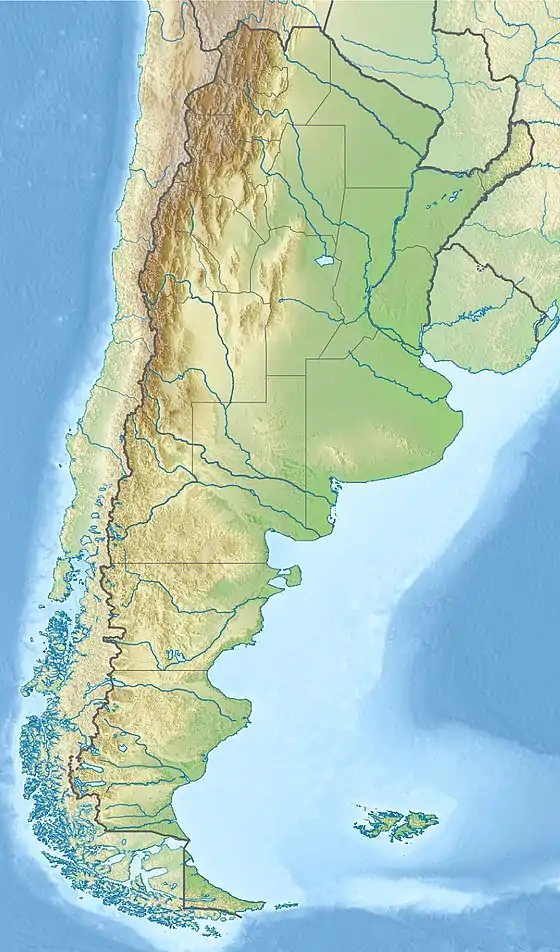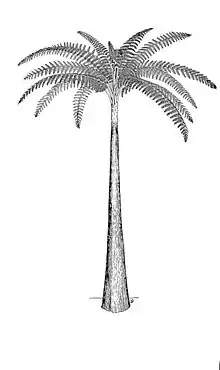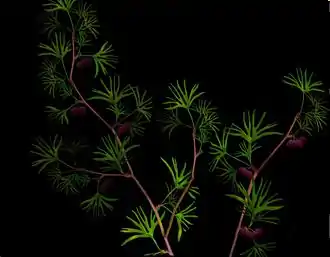Paso Flores Formation
The Paso Flores Formation is a latest Late Triassic (Rhaetian) geologic formation in the Neuquén Basin of Neuquén Province in northwestern Patagonia, Argentina. The brown to red-stained conglomerates, sandstones and shales of the formation represent the youngest and only latest Triassic edimentary unit in the country, overlying basement.
| Paso Flores Formation Stratigraphic range: Latest Late Triassic ~205–202 Ma | |
|---|---|
| Type | Geological formation |
| Underlies | Sañicó, Nestares, Collón Curá, Caleufú & Cerro Petiso Formations |
| Overlies | Cushamen basement |
| Thickness | Up to 230 m (750 ft) |
| Lithology | |
| Primary | Conglomerate, sandstone |
| Other | Shale |
| Location | |
| Coordinates | 40.5°S 70.5°W |
| Approximate paleocoordinates | 50.1°S 31.1°W |
| Region | Neuquén Province |
| Country | |
| Extent | Southern Neuquén Basin |
| Type section | |
| Named for | Balsa Paso Flores |
| Named by | Fossa Mancini |
| Year defined | 1937 |
 Paso Flores Formation (Argentina) | |
The formation has provided a rich fossil flora of various groups, preserved in leaves and fossil wood in the finer lithologies in the Paso Flores Formation. The fossil flora is representative of the ecosystem of the latest Triassic, preceding the Triassic-Jurassic extinction event.
Description
The formation was first defined by Fossa Mancini in 1937 as the Formación Continental de Paso Flores. Later, Frenguelli (1948) called the formation Estratos de Paso Flores ("Paso Flores Beds") and Galli (1954, 1969) described it as Serie de Paso Flores. Finally, the formation was described as Paso Flores Formation (Nullo, 1979, González Díaz, 1982, Spalletti et al., 1988).[1] based on a type section exposed along the Limay River in the southern Neuquén Basin.[2]
The Paso Flores Formation comprises conglomerates, sandstones and shales.
Extent
The formation crops out in its largest extent around the Limay River and the Ranquel-Huao hill and north of Estancia Corral de Piedra. Other outcrops are found northeast of Estancia Collón Curá y on the right banks of the Collón Curá River and in the cañadones of Pancho and El Pedregoso. The type section is found in the eponymous Paso Flores, on the left (western) banks of the Limay River and around Cerro Mariana.[1] The national roads 40 and 237 cross-cut the formation.[3]
Stratigraphy
Separated by a marked unconformity, the formation overlies the Paleozoic crystalline basement of the Cushamen Formation. The Paso Flores Formation is unconformably overlain by the Jurassic Sañicó and Nestares Formations, and Neogene Collón Curá, Caleufú and Cerro Petiso Formations and by alluvium.[2]
The Sañicó Lineament puts the Paso Flores Formation in contact with Famatinian basement.[4]
Age and correlation
González Díaz (1982) assigned a Late Triassic age to the formation, based on a paleofloristic analysis of the Paso Flores Formation executed west of the Collón Curá River. Ganuza et al. (1995) realized a paleobotanical study at Cañadón de Pancho and reached the same conclusion of a Late Triassic age. Zavattieri (1997) observed that the macro- and microflora indicated a Rhaetian age. Several taxa known from the Jurassic are present as well as typical Triassic taxa as Telemachus elongatus and Pagiophyllum. The formation is the only fossiliferous latest Triassic formation.[2]
The Paso Flores Formation is correlated with the Garamilla, Los Menucos and Sierra Colorada Formations elsewhere in Argentina.[5]
Dictyophyllum tenuifolium, whose type locality is the Paso Flores Formation, is also found in the Ladinian Cortaderita Formation of San Juan Province.[6]
Lithology
The Paso Flores Formation is a terrestrial unit with a high fossil content, composed of conglomerates, conglomeratic sandstones and lightbrown sandstones and shales with iron staining. The thickness of the formation varies from 30 metres (98 ft) in the Ranquel Huao hills, 90 metres (300 ft) in the Cañadón de Pancho and according to Frenguelli (1948) and Spalletti et al.(1988), 263 metres (863 ft) in Estancia Paso Flores and Cerro Mariana.[1]
The well-consolidated conglomerates comprise rounded polymict granitic and volcanic clasts of up to 20 centimetres (7.9 in) in a sandy matrix. Intercalated in the conglomerates are lenses of fine-to-medium grained sandstones and shales preserving fossil leaves and fossilized treetrunks.[1]
Fossil content
The Paso Flores has provided a variety of flora fossils, reported from three outcrops:[7] In 2003, more specific descriptions were carried out of Cladophlebis grahami, C. denticulata, Dictyophyllum chihuiuensis, D. tenuiserratum and D. rothi, Rhexoxylon brunoi, Dicroidium crassum, D. odontopteroides, D. lancifolium, Xylopteris argentina and X. elongata. Abundant other flora are Scleropteris grandis, Linguifolium arctum, L. lilleanum, L. tenisonwoodsii and L. steinmannii, Cycadocarpidium and Heidiphyllum, Telemachus and Protocircoporoxylon marianaensis.[2]
In 2017, several flora were described; Lutanthus ornatus, Rissikistrobus plenus, Rissikistrobus reductus, Rissikia media, Umkomasia sp., Sphenobaiera argentinae, Pseudoctenis spatulata, Taeniopteris crassinervis and Yabeiella brackebuschiana.[8]
Additionally, Baiera triassica, in replacement of the homonymous species previously identified in Argentina as Baiera taeniata, Ginkgo taeniata and Sphenobaiera taeniata, were described as well as new species previously described from other locations than the analyzed Quemquemtreu area of the Cañadón Pancho locality. These species are: Asterotheca rigbyana, Marattiopsis muensteri, Cladophlebis kurtzii, C. indica, Dictyophyllum (Dictyophyllum) tenuifolium, Goeppertella stipanicicii, Dicroidium incisum, D. odontopteroides, D. lancifolium, Pachydermophyllum praecordillerae, Heidiphyllum elongatum, Baiera furcata, Sphenobaiera robusta, Pseudoctenis carteriana and P. falconeriana.[8]
Paso Flores
- PGAP 2402 - Spalletti et al. (1988)[9]
- Pinopsida
- Araucarioxylon sp.
- Araucarites sp.
- Peltaspermopsida
- Dicroidium sp.
- Xylopteris sp.
- Peltaspermopsida
- Ginkgoopsida
- Baiera sp.
- Czekanowskia sp.
- Ginkgoites sp.
- Pinopsida
- Podozamites sp.
- Desmiophyllum sp.
- Pseudoctenis sp.
- Polypodiopsida
- Coniopteris sp.
- Dictyophyllum sp.
- Polypodiopsida
Cañadón del Ranquel Huao
- PGAP 2403 - idem[9]
- Peltaspermopsida
- Ginkgoopsida
- Pinopsida
- Asterotheca sp.
- Kurtziana sp.
- Pachydermophyllum sp.
- Podozamites sp.
- Pseudoctenis sp.
- Polypodiopsida
- Cladophlebis sp.
- Coniopteris sp.
- Dictyophyllum sp.
- Thaumatopteris sp.
Cañadón de Pancho
- PGAP 2404 - Artabe et al. (1994)[10]
- Ginkgoopsida
- Cycadocarpidium sp.
- Czekanowskia sp.
- Johnstonia sp.
- Nilsonia sp.
- Pseudoctenis sp.
- Scleropteris sp.
- Taeniopteris sp.
- Zuberia sp.
- Peltaspermopsida
- Dicroidium sp.
- Heidiphyllum sp.
- Linguifolium sp.
- Sphenobaiera sp.
- Xylopteris sp.
Additionally, several spores and pollen were described from the formation by Zavattieri and Mego in 2008:[11]
See also
- Tralcán Formation, contemporaneous formation in Chilean northern Patagonia
- Los Colorados Formation, Norian fossiliferous formation of the Ischigualasto-Villa Unión Basin in northwestern Argentina
- Elliot Formation, contemporaneous fossiliferous formation of South Africa
- Fremouw Formation, contemporaneous fossiliferous formation of Antarctica
- Lower Dharmaram Formation, contemporaneous fossiliferous formation of India
- Carapacha Formation, Permian fossil flora-bearing formation of Argentina
References
- Escosteguy, 2013, p.14
- Escosteguy, 2013, p.15
- Zavattieri & Mego, 2008, p.484
- Benedini, 2015, p.135
- Benedini, 2015, p.13
- Bodnar et al., 2018, p.403
- Paso Flores Formation at Fossilworks.org
- Gnaedinger & Zavattieri, 2017
- Spalletti et al., 1988
- Artabe et al., 1994
- Zavattieri & Mego, 2008, pp.485-487
Bibliography
- Bodnar, J.; J.M. Drovandi; E.M. Morel, and D.G. Ganuza. 2018. Middle Triassic dipterid ferns from west-central Argentina and their relationship to palaeoclimatic changes. Acta Palaeontologica Polonica 63. 397-416. Accessed 2020-06-27.
- Gnaedinger, Silvia C., and Ana Maria Zavattieri. 2017. First Record of Voltzialean Male Cone (Lutanthus) and Podocarpacean Female Cone (Rissikistrobus) from the Late Triassic of Argentina, Including New Plant Remains from the Paso Flores Formation. Ameghiniana 54. 224-246. doi:10.5710/AMGH.18.10.2016.2986
- Benedini, Leonardo. 2015. Análisis de las sucesiones volcaniclásticas Gondwano-Patagonídicas del sector occidental de la Comarca Nordpatagónica, 1-207. Universidad Nacional del Sur.
- Escosteguy, L., S. Geuna, M. Franchi, E. González Díaz, C. Dal Molín, M. Cegarra, C. Wilson, M. Etcheverría and R. González. 2013. Hoja Geológica 4172-II, San Martín de los Andes. Provincias del Neuquén y de Río Negro, 1-92. Instituto de Geología y Recursos Minerales Servicio Geológico Minero Argentino Boletín 409. Accessed 2020-06-27.
- Zavattieri, Ana María, and Natalia Mego. 2008. Palynological record of the Paso Flores Formation (Late Triassic) on the southeastern side of the Limay River,Patagonia, Argentina. Ameghiniana 45. 480-499. Accessed 2020-06-27.
- Artab, A. E.; E.M. Morel, and A.B. Zamuner. 1994. Estudio paleobotánico y tafonómico en la Formación Paso Flores (Triásico Superior), en el Cañadón de Pancho, Neuquén, Argentina. Ameghiniana 31. 153-160.
- Spalletti, L. A.; O.G. Arrondo; E.M. Morel, and D.G. Ganuza. 1988. Estudio sedimentologico y paleofloristico de la Formacion Paso Flores (Triasico Superior) en el sector occidental del Macizo Norpatagonico, Argentina, 395-413. V Congreso Geologico Chileno.
Further reading
- Herbst, R. 1993. Dipteridaceae (Filicales) del Triásico del Arroyo Llantenes (provincia de Mendoza) y de Paso Flores (provincia del Neuquén), Argentina. Ameghiniana 30. 155–162.
- Bonaparte, J.F. 1978. El Mesozóico de América de Sur y sus Tetrapodos - The Mesozoic of South America and its tetrapods. Opera Lilloana 26. 1–596.
- Bonetti, M.I.R., and R. Herbst. 1964. Dos especies de Dictyophyllum del Triásico de Paso Flores. Provincia del Neuquén, Argentina. Ameghiniana 3. 273–279.



